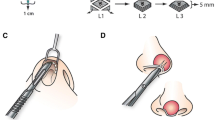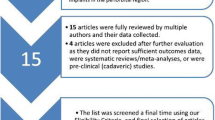Abstract
Background
Alloplastic materials in facial surgery have been used successfully for various applications in the reconstructive restoration or aesthetic augmentation of the facial skeleton. The objective of this study was to conduct a comprehensive systematic review of alloplastic implant materials utilized to augment the facial skeleton stratified by anatomical distribution, indication, specific material used, and respective outcomes.
Methods
A comprehensive systematic review on alloplastic facial implant data was conducted utilizing Medline/PubMed database. Articles were stratified by (1) anatomic localization in the face, as well as (2) alloplastic material.
Results
A total of 17 studies (n = 2100 patients, follow-up range = 1 month–27 years) were included. Overall, mersilene mesh implants were associated with the highest risk of infection (3.38%). Methyl methacrylate implants were associated with the highest rate of hematoma (5.98%). Implants placed in the malar region (2.67%) and frontal bones (2.50%) were associated with the highest rates of infection. Implants placed in the periorbital region were associated with the highest rate of inflammation (8.0%), explantation (8.0%), and poor cosmetic outcome (17.0%). Porous implants were shown to be more likely to potentiate infection than non-porous implant types.
Conclusions
Alloplastic facial implants are a reliable means of restoring facial symmetry and achieving facial skeletal augmentation with a relatively low complication profile. It is important for plastic surgeons to understand the relative risks for each type of implant to develop postoperative complications or poor long-term cosmetic results. Interestingly, porous implants were shown to be more likely to potentiate infection than non-porous implant types.
Level of Evidence III
This journal requires that authors assign a level of evidence to each article. For a full description of these Evidence-Based Medicine ratings, please refer to the Table of Contents or the online Instructions to Authors www.springer.com/00266.

















Similar content being viewed by others
References
Frodel JL, Lee S (1998) The use of high-density polyethylene implants in facial deformities. Arch Otolaryngol Head Neck Surg 124(11):1219–1223
Cuzalina LA, Hlavacek MR (2009) Complications of facial implants. Oral Maxillofac Surg Clin N Am 21(1):91–104
Gear AJ, Lokeh A, Aldridge JH, Migliori MR, Benjamin CI, Schubert W (2002) Safety of titanium mesh for orbital reconstruction. Ann Plast Surg 48(1):1–9
Klawitter JJ, Bagwell JG, Weinstein AM, Sauer BW, Pruitt JR (1976) An evaluation of bone growth into porous high density polyethylene. J Biomed Mater Res 10(2):311–323
Winkler AA, Soler ZM, Leong PL, Murphy A, Wang TD, Cook TA (2012) Complications associated with alloplastic implants in rhinoplasty. Arch Facial Plast Surg 14(6):437–441
Wellisz T (1993) Clinical experience with the Medpor porous polyethylene implant. Aesthetic Plast Surg 17(4):339–3448273538
Türegün M, Sengezer M, Güler M (1998) Reconstruction of saddle nose deformities using porous polyethylene implant. Aesthetic Plast Surg 22(1):38–419456353
Romo T III, Sclafani AP, Sabini P (1998) Use of porous high-density polyethylene in revision rhinoplasty and in the platyrrhine nose. Aesthetic Plast Surg 22(3):211–2219618188
Ahn J, Honrado C, Horn C (2004) Combined silicone and cartilage implants: augmentation rhinoplasty in Asian patients. Arch Facial Plast Surg. 6(2):120–123
Bertossi D, Galzignato PF, Albanese M et al (2015) Chin microgenia: a clinical comparative study. Aesthet Plast Surg 39(5):651–658
Chang C, Kong WK (2014) Clinical effectiveness and safety of collagen sheet for dorsal augmentation in rhinoplasty. J Craniofac Surg 25(5):1852–1854
Demirkan F, Arslan E, Unal S, Aksoy A (2003) Irradiated homologous costal cartilage: versatile grafting material for rhinoplasty. Aesthetic Plast Surg 27(3):213–220
Erol OO, Enacar A (2003) Augmentation mentoplasty using a custom-design wire cage. J Craniofac Surg 14(6):884–892
Fanous N, Tournas A, Côté V et al (2017) Soft and firm alloplastic implants in rhinoplasty: why, when and how to use them: a review of 311 cases. Aesthetic Plast Surg 41(2):397–412
Gross EJ, Hamilton MM, Ackermann K, Perkins SW (1999) Mersilene mesh chin augmentation. A 14-year experience. Arch Facial Plast Surg. 1(3):183–189 (discussion 190)
Hollier LH, Rogers N, Berzin E, Stal S (2001) Resorbable mesh in the treatment of orbital floor fractures. J Craniofac Surg 12(3):242–246
Holmes AD, Lee SJ, Greensmith A, Heggie A, Meara JG (2010) Nasal reconstruction for maxillonasal dysplasia. J Craniofac Surg 21(2):543–551
Hopping SB, Joshi AS, Tanna N, Janjanin S (2010) Volumetric facelift: evaluation of rhytidectomy with alloplastic augmentation. Ann Otol Rhinol Laryngol 119(3):174–180
Lustica I, Velepic M, Cvjetković N et al (2001) Polymethyl-methacrylate implants in forehead and supraorbital arches reconstruction: retrospective study. Coll Antropol 25(Suppl):137–143
Niechajev I (2012) Facial reconstruction using porous high-density polyethylene (medpor): long-term results. Aesthetic Plast Surg 36(4):917–927
Nocini PF, Boccieri A, Bertossi D (2009) Gridplan midfacial analysis for alloplastic implants at the time of jaw surgery. Plast Reconstr Surg 123(2):670–679
Park DK, Song I, Lee JH, You YJ (2013) Forehead augmentation with a methyl methacrylate onlay implant using an injection-molding technique. Arch Plast Surg 40(5):597–602
Robiony M, Costa F, Demitri V, Politi M (1998) Simultaneous malaroplasty with porous polyethylene implants and orthognathic surgery for correction of malar deficiency. J Oral Maxillofac Surg. 56(6):734–741 (discussion 742)
Shadfar S, Farag A, Jarchow AM, Shockley WW (2015) Safety and efficacy of expanded polytetrafluoroethylene implants in the surgical management of traumatic nasal deformity. JAMA Otolaryngol Head Neck Surg 141(8):710–715
Yaremchuk MJ (2003) Improving aesthetic outcomes after alloplastic chin augmentation. Plast Reconstr Surg 112(5):1422–1432 (discussion 1433-4)
Alonso N, de Pochat VD, de Barros AR, Tavares LS (2013) Long-term complication after rhinoplasty using porous polyethylene implant: cutaneous fistula of the forehead. J Craniofac Surg 24(6):2176–2178
Bain CJ, Odili J (2012) Late infection of an alloplastic chin implant masquerading as squamous cell carcinoma. J Plast Reconstr Aesthet Surg 65(6):e151–e152
Emsen IM, Benlier E (2008) A new approach on reconstruction of frontonasal encephalomeningocele assisted with medpor. J Craniofac Surg 19(2):537–539
Eufinger H, Wehmöller M, Scholz M, Harders A, Machtens E (1999) Reconstruction of an extreme frontal and frontobasal defect by microvascular tissue transfer and a prefabricated titanium implant. Plast Reconstr Surg 104(1):198–203
Graham BS, Thiringer JK, Barrett TL (2001) Nasal tip ulceration from infection and extrusion of a nasal alloplastic implant. J Am Acad Dermatol 44(2 Suppl):362–364
Greene AK, Warren SM, McCarthy JG (2008) Onlay frontal cranioplasty using wire reinforced methyl methacrylate. J Craniomaxillofac Surg 36(3):138–142
Hoffmann C, Schuller-Petrovic S, Soyer HP, Kerl H (1999) Adverse reactions after cosmetic lip augmentation with permanent biologically inert implant materials. J Am Acad Dermatol 40(1):100–102
Pak MW, Chan ES, van Hasselt CA (1998) Late complications of nasal augmentation using silicone implants. J Laryngol Otol 112(11):1074–1077
Saray A (2003) Porcine dermal collagen (Permacol) for facial contour augmentation: preliminary report. Aesthetic Plast Surg. 27(5):368–375
Scolozzi P (2012) Maxillofacial reconstruction using polyetheretherketone patient-specific implants by “mirroring” computational planning. Aesthet Plast Surg 36(3):660–665
Stalder MW, St Hilaire H (2012) Immediate osseous genioplasty with Kirschner wire fixation for revision of infected alloplastic chin implant. J Craniofac Surg 23(5):e446–e447
Tieghi R, Consorti G, Clauser LC (2012) Contouring of the forehead irregularities (washboard effect) with bone biomaterial. J Craniofac Surg 23(3):932–934
Raghavan U, Jones NS, Romo T 3rd (2004) Immediate autogenous cartilage grafts in rhinoplasty after alloplastic implant rejection. Arch Facial Plast Surg 6(3):192–196
Quatela VC, Chow J (2008) Synthetic facial implants. Fac Plast Surg Clin N Am 16(1):1–10
Sclafani AP, Romo T III (2000) Biology and chemistry of facial implants. Facial Plast Surg 16(01):003–006
Dale EL, Sargent LA (2015) Bilateral erosion of malar implants into the maxillary sinuses. Plast Surg Case Stud 1(2):32–34
Wellisz T, Lawrence M, Jazayeri MA, Golshani S, Zhou ZY (1995) The effects of alloplastic implant onlays on bone in the rabbit mandible. Plast Reconstr Surg 96(4):957–963
Ren W, Wu B, Mayton L, Wooley PH (2002) Polyethylene and methyl methacrylate particle-stimulated inflammatory tissue and macrophages up-regulate bone resorption in a murine neonatal calvaria in vitro organ system. J Orthop Res 20(5):1031–1037
Peled IJ, Wexler MR, Ticher S, Lax EE (1986) Mandibular resorption from silicone chin implants in children. J Oral Maxillofac Surg 44(5):346–348
Peled ZM, Warren AG, Johnston P, Yaremchuk MJ (2008) The use of alloplastic materials in rhinoplasty surgery: a meta-analysis. Plast Reconstr Surg 121(3):85e–92e
Deva AK, Merten S, Chang L (1998) Silicone in nasal augmentation rhinoplasty: a decade of clinical experience. Plast Reconstr Surg 102:1230–1237
Graham BS, Thiringer JK, Barrett TL (2001) Nasal tip ulceration from infection and extrusion of a nasal alloplastic implant. J Am Acad Dermatol 44(2):362–364
Park DK, Song I, Lee JH, You YJ (2013) Forehead augmentation with a methyl methacrylate onlay implant using an injection-molding technique. Arch Plast Surg 40(5):597
Kiechel SF, Rodeheaver GT, Klawitter JJ, Edgerton MT, Edlich RF (1977) The role of implant porosity on the development of infection. Surg Gynecol Obstet 144(1):58–62
Lohuis PJFM, Watts SJ, Vuyk HD (2001) Augmentation of the nasal dorsum using Gore-Tex®: intermediate results of a retrospective analysis of experience in 66 patients. Clin Otolaryngol Allied Sci 26(3):214–217
Adams JR, Kawamoto HK (1995) Late infection following aesthetic malar augmentation with proplast implants. Plast Reconstr Surg 95(2):382–384
Staffel G, Shockley W (1995) Nasal implants. Otolaryngol Clin North Am 28(2):295–308
Rubin JP, Yaremchuk MJ (1997) Complications and toxicities of implantable biomaterials used in facial reconstructive and aesthetic surgery: a comprehensive review of the literature. Plast Reconstr Surg 100(5):1336–1353
Author information
Authors and Affiliations
Corresponding author
Ethics declarations
Conflict of interest
The authors declare that they have no conflicts of interest.
Human and Animal Rights
This article does not contain any studies with human participants or animals performed by any of the authors.
Informed Consent
For this type of study, informed consent is not required.
Additional information
Publisher's Note
Springer Nature remains neutral with regard to jurisdictional claims in published maps and institutional affiliations.
This study was supported in part by the Mayo Clinic Robert D. and Patricia E. Kern Center for the Science of Health Care Delivery.
Electronic Supplementary Material
Below is the link to the electronic supplementary material.
Rights and permissions
About this article
Cite this article
Oliver, J.D., Eells, A.C., Saba, E.S. et al. Alloplastic Facial Implants: A Systematic Review and Meta-Analysis on Outcomes and Uses in Aesthetic and Reconstructive Plastic Surgery. Aesth Plast Surg 43, 625–636 (2019). https://doi.org/10.1007/s00266-019-01370-0
Received:
Accepted:
Published:
Issue Date:
DOI: https://doi.org/10.1007/s00266-019-01370-0




